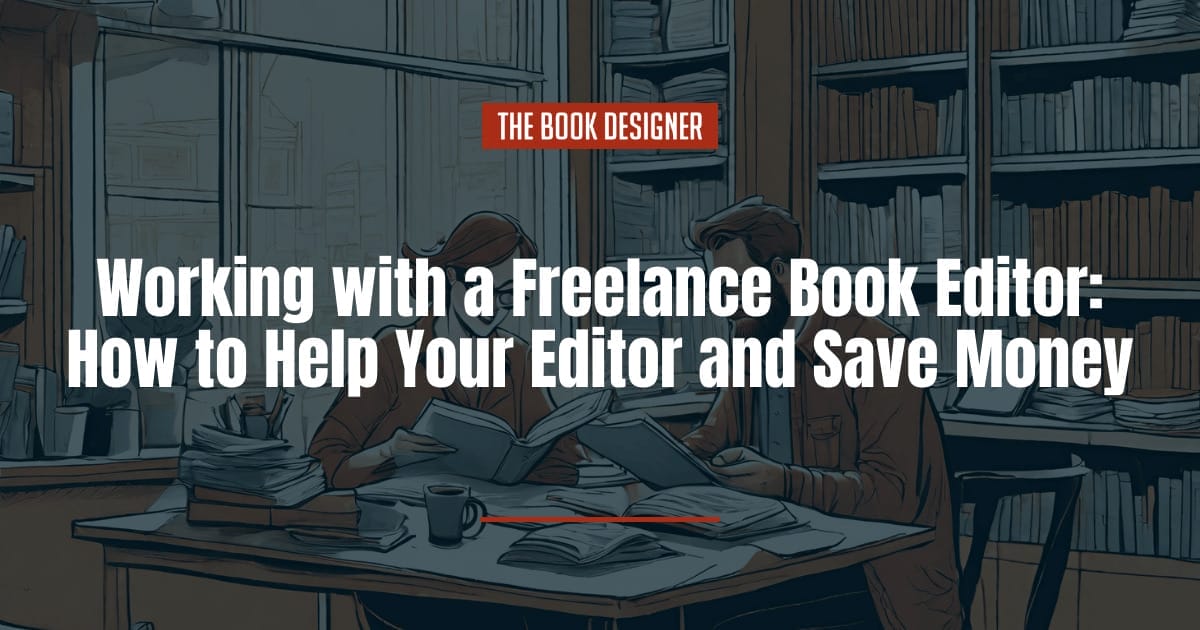You’ve written a book, and it’s time to send it to a freelance book editor.
Or is it?
That depends on how much work you want your editor to do. It may also depend on how deep your pockets are!
What if we told you that there are some things you can do yourself and that by doing them, you’ll learn a lot about writing and save on editing costs?
Below are four things you can do to get your book manuscript ready for your editor. Some of these tasks are on our list of editing pet peeves, mostly because they’re not the best use of a freelance book editor’s time. All are within reach of a writer’s abilities.
Some of the suggestions described below apply to nonfiction writers only. If you write fiction, you get a free pass on those.
Note: The list below assumes that you’ve already addressed big-picture items in your book, such as content, structure, plot, pacing, and any characterization issues.
Here are some ways to make working with a freelance book editor more time- and cost-effective:
1. Assess Your Manuscript
Before you attempt any of the tasks we suggest below, you’ll need to get a general sense of what your book needs and what you can reasonably do to help your editor. Two things can help you see your book through an editor’s eyes: revision tools and a style guide.
Run Revision Tools
If you’re not sure how to assess your book, run some revision tools on it. They’ll alert you to potential problems in your writing, so you can fix them. You’ll find tips on how to use revision tools at Tech Tools for Writers.
Pick a tool and spend a few minutes learning how to use it. Using even one tool can save on editing costs and teach you some valuable lessons about writing that you can apply to your next book.
Tip: If you only have time for one tool, we’d recommend the Hemingway Editor.
Consult a Style Guide
Now that you have a sense of what your writing might need, you can figure out how to fix those problems by looking them up in a writer’s style guide.
We recommend You’ve Got Style: A Writer’s Guide to Copyediting, written by two editors we know. Not everyone has the time or interest to read the Chicago Manual of Style—an excellent 1000-page style guide geared to editors. But, if writing is your business and you want to become better at it, we think a short guide will help you to see what you need to.
2. Pre-Edit Before Sending to Your Freelance Book Editor
Now that you know what to fix and where you can go to find out how to fix it, it’s time to pre-edit. The better shape your manuscript is in, the less time your editor will have to spend editing it.
You don’t need to know everything about editing. We’ve listed a handful of things you can learn and do that will save your editor time (and your money).
The items we’ve listed below are not difficult to address. They are time-consuming, though. Currently, there are no nifty automated tools that will help editors deal with these items efficiently. That’s why they’re on this list. A freelance book editor must address them manually, and manual tasks take longer, which means editing can cost more.
If you’re short on money and long on time, you can address these items yourself:
Sentence Length
Too many long sentences can make your text dense and difficult to understand. The solution? Shorten your sentences.
If you’re attempting to make reading a seamless process for readers, aim for the 20-word sentence. This isn’t a hard-and-fast rule, and a 20-word sentence won’t make sense all the time, but it’s a good target to keep in mind.
Tip: Use the Hemingway Editor to help you see which sentences need pruning.
Capitalization
Capitalize thoughtfully, not randomly. We get it. There are a lot of capitalization rules (refer to You’ve Got Style for the most important ones). If you’re not sure if a word needs caps, leave it in lowercase letters.
Keep a list of the words you’ve capitalized. Your editor can assess them and then ensure that those words are capitalized consistently throughout your book.
Headings
Check that chapter and section headings are styled correctly and consistently. You’ll need to decide
- on font size and type
- if a heading will be set in italics, boldface, or roman
- what level a heading is (H1, H2, H3, etc.)
- whether to use title case or sentence case
If these decisions sound like a foreign language to you, turn to your trusty style guide for advice, and give it your best shot.
Tip: Styling headings is much easier if you know how to apply styles to headings using the styles feature in your word processor. That way, if you or your editor needs to correct a heading style, you can do it quickly and simply. A change to an H1 heading style, for example, can then be applied to all H1 headings in your book, in just a few minutes.
If you’ve applied styles using the buttons on the ribbon or toolbar in your word processor, your editor will need to change every heading individually. There can be a lot of headings in a book, particularly a nonfiction book. Remember, a freelance book editor’s time is your money.
Lists
If you’re writing nonfiction, you’ll want to use lists to create white space, which makes writing more readable. Lists can be styled in many ways.
Consult a style guide to learn
- how to punctuate lead-ins and list items
- how and when to use capital letters for list items
- how to arrange the items in a list
Freelance book editors can spend a lot of time styling lists if the author has styled them inconsistently. A little list study on your part can free your editor up to do other, more important tasks.
Citations and References
If you’re writing nonfiction, particularly academic nonfiction, you will need to decide how to handle in-text citations and the accompanying references list or bibliography. If you leave this task to your freelance book editor, it will cost you. Dearly.
Citations and references aren’t difficult to get right. But they can be a time trap if you have to hunt them down and fix them after the fact. It’s not uncommon for an editor to spend as much time editing your citations and references as it takes to edit the rest of your book!
Fortunately, writers can head off this time (and money) trap from the beginning. Consult a style guide—APA, MLA, Chicago, or The Ebook Style Guide if you’re publishing an ebook—to understand how you’ll need to style citations. Then, check the documentation for your word processor to see if it has a built-in tool that will automate your citation style and reference list as you write.
For example, Microsoft Word has a References and Citation tool (2010 and later) to help you create consistently styled citations. You could also investigate bibliography generators, such as EasyBib Bibliography Creator for Google Docs, or Edifix.
The pre-editing tasks listed above may seem nitpicky, but it’s amazing how much time they can take. If you’re able to handle them, you can free up your editor to focus on the higher-order tasks that will make your writing shine.
3. Clean Up Your Formatting
Freelance book editors can spend valuable time cleaning up “typewriter formatting,” such as
- extra tab spaces
- extra spaces between words
- double spaces after end punctuation
- straight quotes (they should be curly)
- stray empty paragraphs
…and so on.
You can learn how to clean up your formatting using the find and replace function in your word processor. For example, to delete tabs in Microsoft Word, insert the code for a tab in the find field:
Find: ^t
Replace with: [leave blank]
Refer to this handy list of find and replace codes for other nonprint characters that you can search for in Word. If you use Scrivener, consult the Scrivener manual for how to copy and paste nonprint characters into Scrivener’s find and replace feature.
Tip: If you’d rather do your all find-and-replace moves at once, try FRedit, a free find-and-replace macro that works in Microsoft Word. Once you set up a list of find and replace moves in FRedit, you can use this list to clean up all your books.
4. Send Your Freelance Book Editor Their Preferred Format Manuscript
Many editors edit in Word. Why? Word works with a bevy of editing tools and add-ins that allow editors to edit quickly and accurately. Word also has built-in tools that deal effectively with certain editing tasks. Asking an editor to edit in anything other than Word is like painting a wall with a cotton swab. Doable, but entirely inefficient.
That said, some freelance book editors may prefer to use other applications, such as Google Docs. This is why it’s important to ask your editor what format they prefer.
Many writers are beginning to use apps like Scrivener for writing. You can ask an editor to edit your book in Scrivener, but we wouldn’t recommend it. It’ll take your editor longer and cost you more money.
Instead, compile your book file to a Word .docx file (or whatever format your editor prefers) and send that to your editor. If you can’t read the edited .docx file because you don’t have Word on your computer, ask your editor to save the edits as a PDF.
What’s Left?
You might be wondering: If I do everything suggested in this post, what’s left for a freelance book editor to do? Plenty, we assure you. Your editor will spend the remaining time on higher-order copyediting tasks.
Of course, you don’t have to do any of the editing types we suggest, and in the end, you might decide that you just don’t want to. That’s okay. If time is more valuable to you than money, an editor will be happy to step in and do these tasks for you.



